Consumer Description by Check-All-That-Apply Questions (CATA) of the Sensory Profiles of Commercial and New Mandarins. Identification of Preference Patterns and Drivers of Liking
Abstract
1. Introduction
2. Materials and Methods
2.1. Samples
2.2. Physico-Chemical Evaluation
2.3. Consumer Study
2.4. Statistical Analysis
3. Results and Discussion
3.1. Physico-Chemical Parameters
3.2. Consumer Responses
3.2.1. Identification of Preference Patterns
3.2.2. CATA Questions
Harvest 1
Harvest 2
3.3. Relationship between the Sensory and Instrumental Data
4. Conclusions
Supplementary Materials
Author Contributions
Funding
Acknowledgments
Conflicts of Interest
References
- Goldenberg, L.; Yaniv, Y.; Kaplunov, T.; Doron-Faigenboim, A.; Carmi, N.; Porat, R. Diversity in sensory quality and determining factors influencing mandarin flavor liking. J. Food Sci. 2015, 80, 418–425. [Google Scholar] [CrossRef] [PubMed]
- Goldenberg, L.; Yaniv, Y.; Porat, R.; Carmi, N. Mandarin fruit quality: A review. J. Sci. Food Agric. 2018, 98, 18–26. [Google Scholar] [CrossRef] [PubMed]
- UNECE STANDARD FFV-14 Citrus Fruit (2017). Available online: https://www.unece.org/fileadmin/DAM/trade/agr/standard/standard/fresh/FFV-Std/English/14_CitrusFruit.pdf/ (accessed on 18 August 2019).
- Morales, J.; Tárrega, A.; Salvador, A.; Navarro, P.; Besada, C. Impact of ethylene degreening treatment on sensory properties and consumer response to citrus fruits. Food Res. Int. 2020, 127, 108641. [Google Scholar] [CrossRef] [PubMed]
- Navarro, L.; Aleza, P.; Cuenca, J.; Juárez, J.; Pina, J.A.; Ortega, C.; Navarro, A.; Ortega, V. The mandarin triploid breeding program in Spain. Acta Hortic. 2015, 1065, 389–396. [Google Scholar] [CrossRef]
- Jaeger, S.R.; Rossiter, K.L.; Wismer, W.V.; Harker, F.R. Consumer-driven product development in the kiwifruit industry. Food Qual. Prefer. 2003, 14, 187–198. [Google Scholar] [CrossRef]
- Gamble, J.; Jaeger, S.R.; Harker, F.R. Preferences in pear appearance and response to novelty among Australian and New Zealand consumers. Postharvest Biol. Technol. 2006, 41, 38–47. [Google Scholar] [CrossRef]
- Rocha, M.D.C.; Deliza, R.; Corrêa, F.M.; do Carmo, M.G.; Abboud, A.C. A study to guide breeding of new cultivars of organic cherry tomato following a consumer-driven approach. Food Res. Int. 2013, 51, 265–273. [Google Scholar] [CrossRef]
- Kelley, K.; Hyde, J.; Travis, J.; Crassweller, R. Assessing consumer preferences of scab-resistant apples: A sensory evaluation. HortTechnology 2010, 20, 885–891. [Google Scholar] [CrossRef]
- Villamor, R.R.; Daniels, C.H.; Moore, P.P.; Ross, C.F. Preference mapping of frozen and fresh raspberries. J. Food Sci. 2013, 78, S911–S919. [Google Scholar] [CrossRef]
- Lawless, H.T.; Heymann, H. Sensory Evaluation of Food, 1st ed.; Champan and Hall: New York, NY, USA, 1998; pp. 341–372, 430–475. [Google Scholar]
- Malundo, T.M.M.; Shewfelt, R.L.; Ware, G.O.; Baldwin, A.E. An alternative method for relating consumer and descriptive data used to identify critical flavor properties of mango (mangifera indica l.). J. Sens. Stud. 2001, 16, 199–214. [Google Scholar] [CrossRef]
- Ares, G.; Barrios, S.; Lareo, C.; Lema, P. Development of a sensory quality index for strawberries based on correlation between sensory data and consumer perception. Postharvest Biol. Technol. 2009, 52, 97–102. [Google Scholar] [CrossRef]
- Delgado, C.; Crisosto, G.M.; Heymann, H.; Crisosto, C.H. Determining the primary drivers of liking to predict consumers’ acceptance of fresh nectarines and peaches. J. Food Sci. 2013, 78, 605–614. [Google Scholar] [CrossRef]
- Varela, P.; Ares, G. Sensory profiling, the blurred line between sensory and consumer science. A review of novel methods for product characterization. Food Res. Int. 2012, 48, 893–908. [Google Scholar] [CrossRef]
- Cruz, A.G.; Cadena, R.S.; Castro, W.F.; Esmerino, E.A.; Rodrigues, J.B.; Gaze, L.; Farina, J.A.F.; Freitas, M.Q.; Deliza, R.; Bolini, H.M.A. Consumer perception of probiotic yogurt: Performance of check all that apply (CATA), projective mapping, sorting and intensity scale. Food Res. Int. 2013, 54, 601–610. [Google Scholar] [CrossRef]
- Tarancón, P.; Salvador, A.; Sanz, T.; Fiszman, S.; Tárrega, A. Use of healthier fats in biscuits (olive and sunflower oil): Changing sensory features and their relation with consumers’ liking. Food Res. Int. 2015, 69, 91–96. [Google Scholar] [CrossRef]
- Torres, F.R.; Esmerino, E.A.; Carr, B.T.; Ferrão, L.L.; Granato, D.; Pimentel, T.; Bolini, H.M.A.; Freitas, M.Q.; Cruz, A.G. Rapid consumer-based sensory characterization of requeijão cremoso, a spreadable processed cheese: Performance of new statistical approaches to evaluate check-all-that-apply data. J. Dairy Sci. 2017, 100, 6100–6110. [Google Scholar] [CrossRef]
- Alencar, N.M.M.; Ribeiro, T.G.; Barone, B.; Barros, A.P.A.; Marques, A.T.B.; Behrens, J.H. Sensory profile and check-all-that-apply (cata) as tools for evaluating and characterizing syrah wines aged with oak chips. Food Res. Int. 2019, 124, 156–164. [Google Scholar] [CrossRef]
- Lado, J.; Vicente, E.; Manzzio, A.; Ares, G. Application of a check-all-that-apply question for the evaluation of strawberry cultivars from a breeding program. J. Sci. Food Agric. 2010, 90, 2268–2275. [Google Scholar] [CrossRef]
- Oliver, P.; Cicerale, S.; Pang, E.; Keast, R. Check-all-that-applies as an alternative for descriptive analysis to establish flavors driving liking in strawberries. J. Sens. Stud. 2018, 33, 1–13. [Google Scholar] [CrossRef]
- Vicente, E.; Ares, G.; Rodríguez, G.; Varela, P.; Bologna, F.; Lado, J. Selection of promising sweet potato clones using projective mapping. J. Sci. Food Agric. 2017, 97, 158–164. [Google Scholar] [CrossRef]
- Mattia, M.R.; Gmitter, F.G. Sensory evaluation of four university of Florida developed-mandarins and a commercial California cultivar. In Proceedings of the Florida State Horticultural Society, Tampa, FL, USA, 4–6 June 2017; 30; pp. 60–63. [Google Scholar]
- Hampson, C.R.; Quamme, H.A.; Hall, J.W.; MacDonald, R.A.; King, M.C.; Cliff, M.A. Sensory evaluation as a selection tool in apple breeding. Euphytica 2000, 111, 79–90. [Google Scholar] [CrossRef]
- Jiménez-Cuesta, M.; Cuquerella, J.; Martinez-Jávega, J.M. Determination of a color index for citrus fruit degreening. In Proceedings of the International Society of Citriculture/International Citrus Congress, Tokyo, Japan, 9–12 November 1981; Matsumoto, K., Ed.; International Society of Citriculture: Shimizu, Japan, 1982; pp. 1982–1983. [Google Scholar]
- International Organization for Standardization (ISO). General Guidance for the Design of Test Room; Standard No. 8589:2007; ISO: Geneva, Switzerland, 2003. [Google Scholar]
- MacFie, H.J.; Bratchell, N.; Greenhoff, K.; Vallis, L.V. Designs to balance the effect of order of presentation and first-order carry-over effects in hall tests. J. Sens. Stud. 1989, 4, 129–148. [Google Scholar] [CrossRef]
- Ares, G.; Dauber, C.; Fernandez, E.; Gimenez, A.; Varela, P. Penalty analysis based on CATA questions to identify drivers of liking and directions for product reformulation. Food Qual. Prefer. 2014, 32, 65–76. [Google Scholar] [CrossRef]
- Simons, T.; Sivertsen, H.; Guinard, J.X. Mapping the preferences of adult and child consumers for California-grown mandarins. HortScience 2018, 53, 1029–1037. [Google Scholar] [CrossRef]
- Simons, T.; McNeil, C.; Pham, V.; Slupsky, C. Comparison of preference clustering outcomes from replicated consumer test. A case of study with mandarins. J. Sens. Stud. 2019, 34, e12533. [Google Scholar] [CrossRef]
- Ares, G.; Rosires, D.; Barreiro, C.; Giménez, A.; Gámbaro, A. Comparison of two sensory profiling techniques based on consumer perception. Food Qual. Prefer. 2010, 21, 417–426. [Google Scholar]
- Ares, G.; Giménez, A.; Barreiro, C.; Gámbaro, A. Use of open-ended question to identify drivers of likig of milk desserts. Comparison with preference mapping techniques. Food Qual. Prefer. 2010, 21, 286–294. [Google Scholar] [CrossRef]
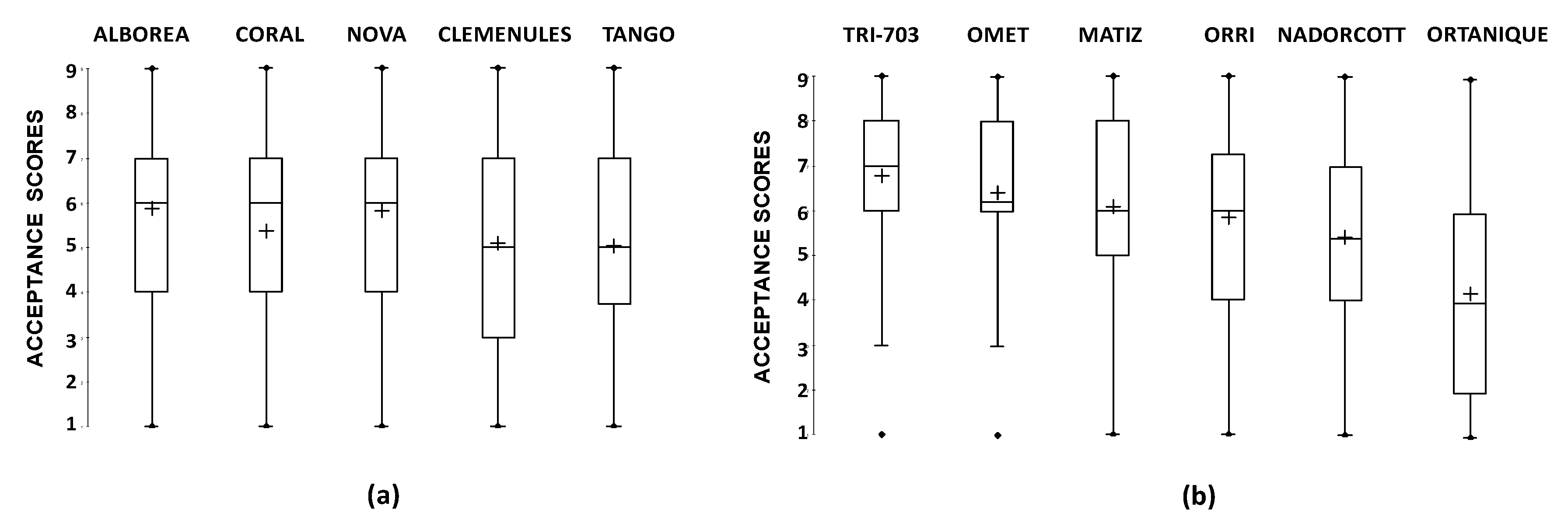
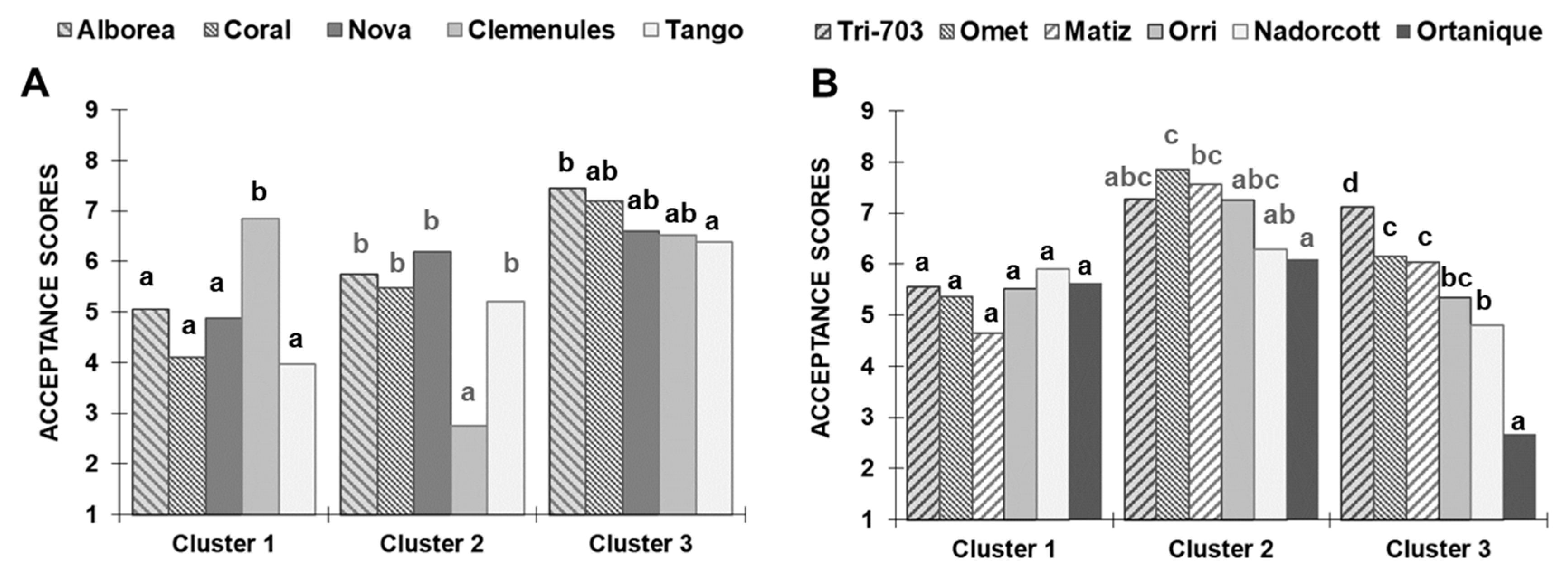
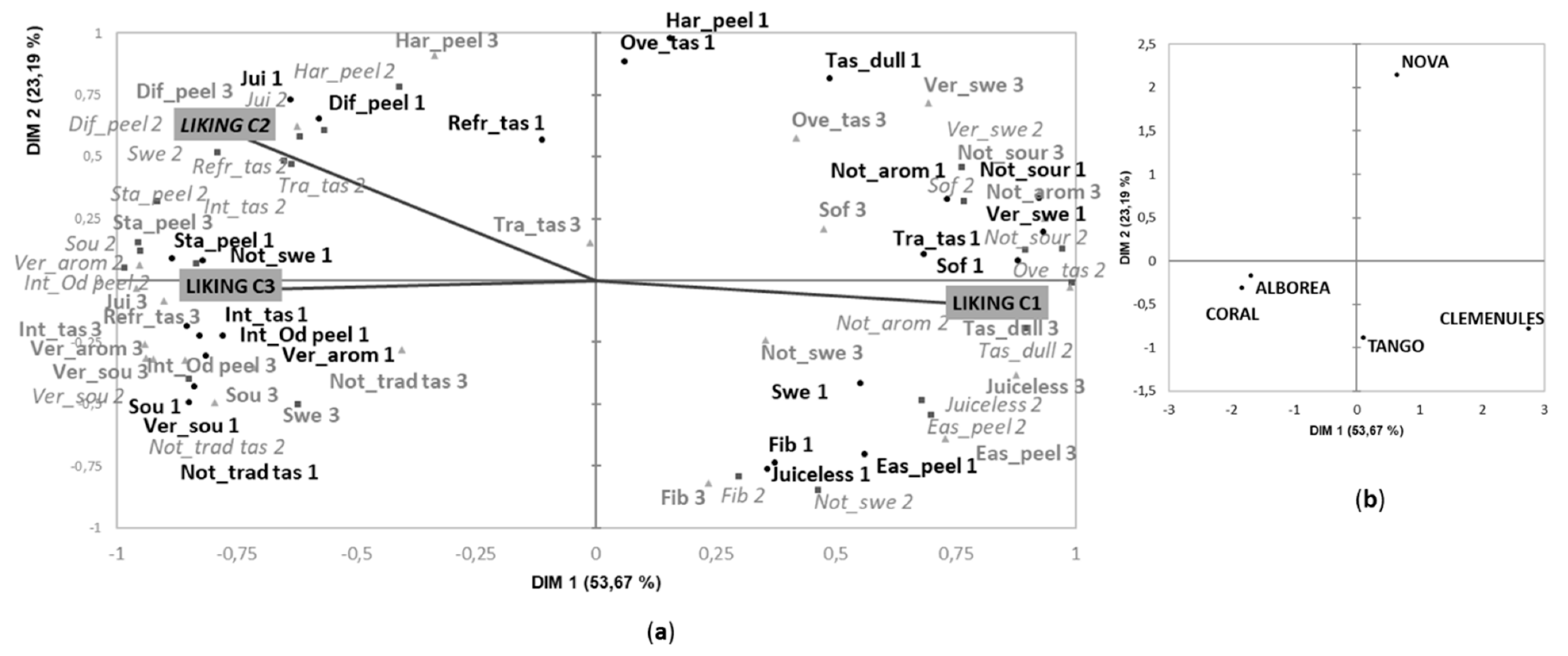
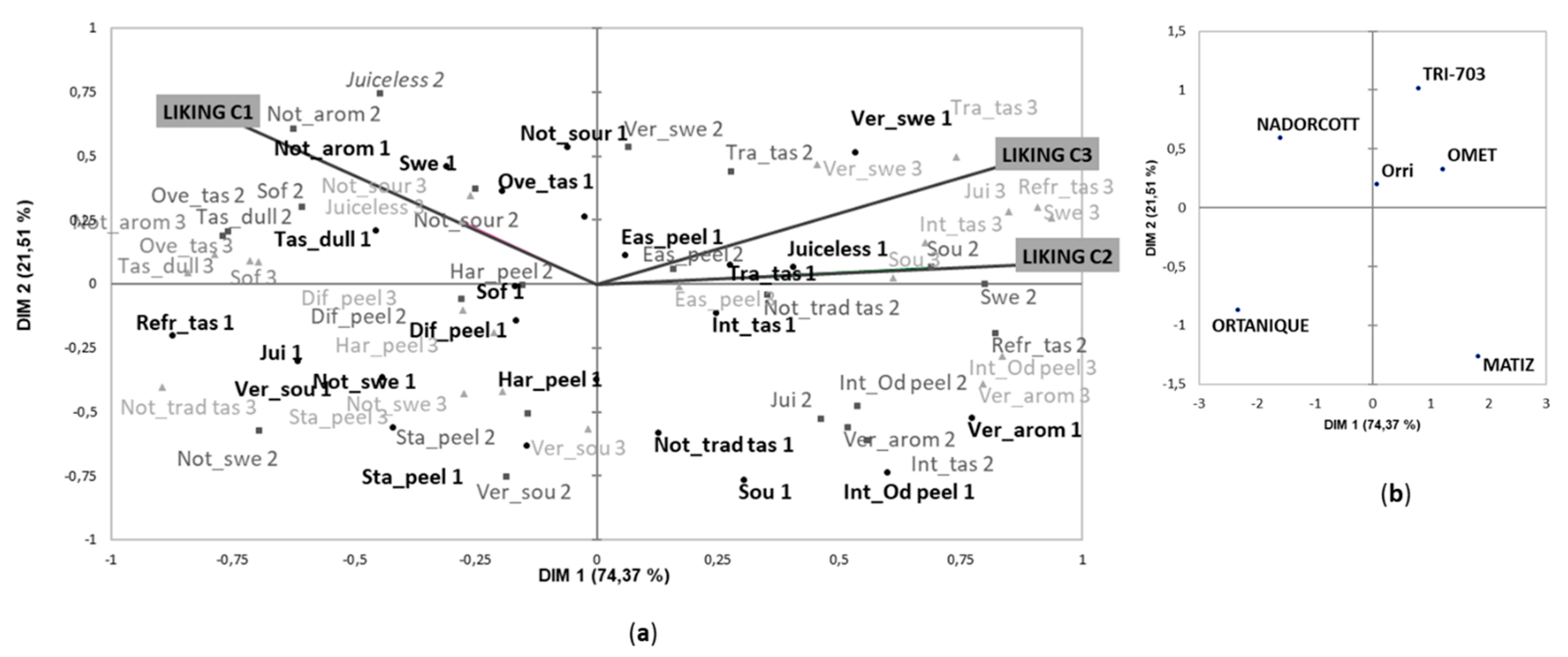
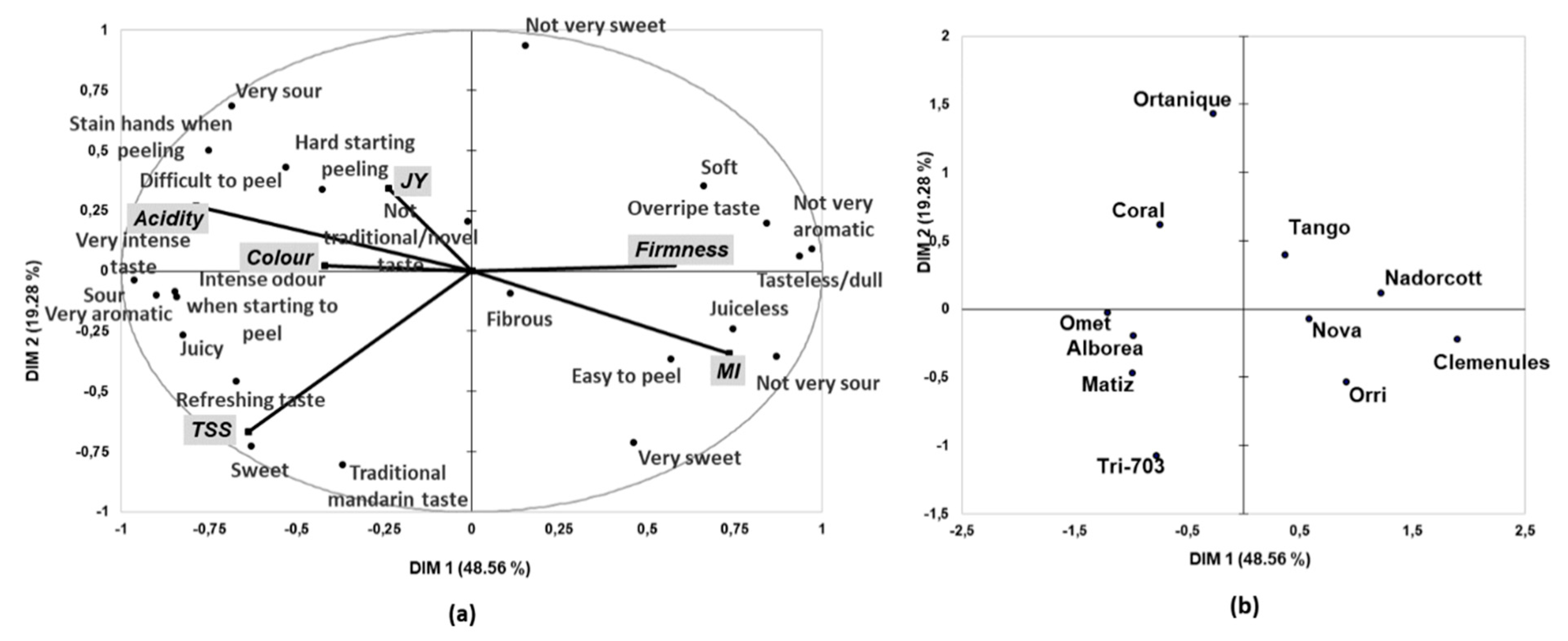
| Harvest | Cultivars | Color (1000a/Lb) | Firmness (%def) | TSS 1 (%) | Acidity (g Citric Acid/100 mL) | MI 2 TSS/TA) | JY 3 (% juice) | Weight (g) |
|---|---|---|---|---|---|---|---|---|
| 1 | Alborea | 27.7 d | 4.1 a | 13.4 b | 1.02 c | 13.08 b | 51.6 a | 107.4 c |
| Coral | 20.4 b | 4.3 ab | 12.6 a | 1.10 c | 11.50 ab | 58.0 b | 110.0 c | |
| Nova | 27.8 d | 4.7 b | 12.4a | 0.74 b | 16.79 c | 57.7 b | 95.54 b | |
| Clemenules | 17.0 a | 6.3 c | 12.1 a | 0.44 a | 27.60 d | 49.2 a | 96.0 b | |
| Tango | 24.9 c | 7.3 d | 11.9 a | 1.10 c | 10.79 a | 51.9 a | 81.8 a | |
| 2 | Tri-703 | 22.2 c | 3.3 c | 14.5 c | 1.25 c | 11.6 c | 48.7 ab | 119.8 a |
| Omet | 23.5 c | 2.1 a | 14.6 c | 1.55 d | 9.45 b | 52.0 b | 126.1 a | |
| Matiz | 18.6 b | 4.3 d | 13.4 b | 1.46 d | 9.19 ab | 49.0 ab | 107.2 a | |
| Orri | 14.2 a | 3.2 c | 13.0 b | 0.67 a | 19.48 d | 50.7 b | 122.4 a | |
| Nadorcott | 17.8 b | 5.4 e | 12.0 a | 1.07 b | 11.29 c | 45.8 a | 98.6 a | |
| Ortanique | 19.1 b | 2.6 b | 11.6 a | 1.50 d | 7.86 a | 51.6 b | 180.5 b |
© 2020 by the authors. Licensee MDPI, Basel, Switzerland. This article is an open access article distributed under the terms and conditions of the Creative Commons Attribution (CC BY) license (http://creativecommons.org/licenses/by/4.0/).
Share and Cite
Tarancón, P.; Tárrega, A.; Aleza, P.; Besada, C. Consumer Description by Check-All-That-Apply Questions (CATA) of the Sensory Profiles of Commercial and New Mandarins. Identification of Preference Patterns and Drivers of Liking. Foods 2020, 9, 468. https://doi.org/10.3390/foods9040468
Tarancón P, Tárrega A, Aleza P, Besada C. Consumer Description by Check-All-That-Apply Questions (CATA) of the Sensory Profiles of Commercial and New Mandarins. Identification of Preference Patterns and Drivers of Liking. Foods. 2020; 9(4):468. https://doi.org/10.3390/foods9040468
Chicago/Turabian StyleTarancón, Paula, Amparo Tárrega, Pablo Aleza, and Cristina Besada. 2020. "Consumer Description by Check-All-That-Apply Questions (CATA) of the Sensory Profiles of Commercial and New Mandarins. Identification of Preference Patterns and Drivers of Liking" Foods 9, no. 4: 468. https://doi.org/10.3390/foods9040468
APA StyleTarancón, P., Tárrega, A., Aleza, P., & Besada, C. (2020). Consumer Description by Check-All-That-Apply Questions (CATA) of the Sensory Profiles of Commercial and New Mandarins. Identification of Preference Patterns and Drivers of Liking. Foods, 9(4), 468. https://doi.org/10.3390/foods9040468






